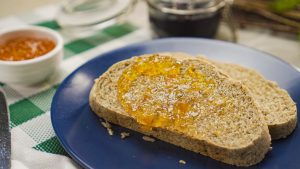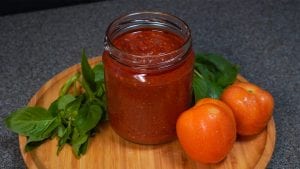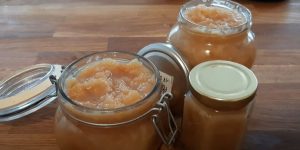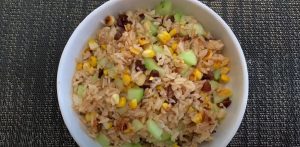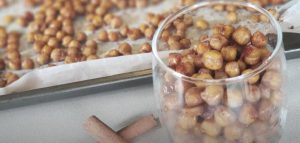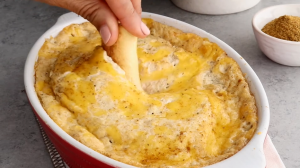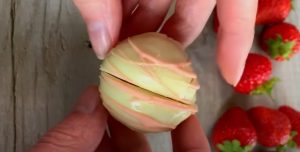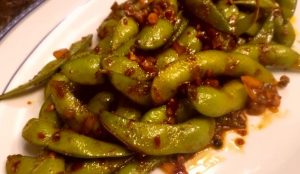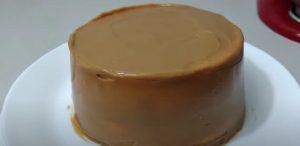Tuscan bread, or Pane Toscano, is a traditional Italian bread that originates from Tuscany. It's unique for its absence of salt which was a result of an ancient tax on salt by the coastal cities of Pisa and Lucca. This bread has a hard crust and a soft, chewy interior which makes it perfect for soaking up sauces and gravies of Tuscan stews and soups.
The ingredients for Tuscan bread are simple and straightforward, but what may not be so common in your pantry is the 'active dry yeast'. It's a type of yeast generally used in bread making and can be found in the baking aisle of any supermarket. Make sure it's 'active' as it needs to ferment and rise the dough.
Ingredients Needed for Tuscan Bread
Active dry yeast: This is a crucial ingredient for making bread. It helps the dough to rise and gives the bread its fluffy texture.
Warm water: Used to activate the yeast and keep the dough at the right consistency.
All purpose flour: This is the main ingredient in bread making, providing structure and texture to the bread.
Oil: Used to grease the bowl and prevent the dough from sticking.
Cornmeal: Adds a nice texture to the bread and also helps prevent it from sticking to the baking stone.
Water in a spray bottle: Used during baking to create steam and give the bread a nice, crispy crust.
One reader, Justin Blankenship says:





This Tuscan bread recipe is a game-changer! The bread turned out crusty on the outside and soft on the inside, just like the authentic Tuscan bread I had in Italy. The flavor was amazing, and the process was surprisingly easy. I'm definitely making this again!
Techniques Required for Making Tuscan Bread
How to prepare the pre-ferment: Dissolve ¼ teaspoon yeast in ⅔ cup warm water in a medium bowl and let stand until foamy, about 10 minutes. Stir in 1⅓ cups flour and mix until blended. Cover with plastic wrap and let stand at room temperature overnight.
How to proof the dough: Lightly grease a large bowl with oil and add the dough. Turn the dough over so it is oiled on all sides. Cover with plastic wrap and let stand for about 1 hour until doubled in bulk.
How to slash the dough: With a clean razor blade or sharp knife, slash a tic-tac-toe grid on top of the dough before baking.
How to bake the bread: Preheat the oven to 450 degrees F and leave the pizza stone/tiles in the oven to preheat. Slide the bread and parchment onto the pizza stone/tiles with a bread or pizza peel or place the baking sheet with the bread into the oven. Bake the bread for 15 minutes, misting the loaf every 5 minutes with water from a spray bottle. Reduce the heat to 400 degrees F and bake the bread for about 25 minutes more until crusty and cooked through.
How to cool the bread: Remove the bread and let it cool completely on a wire rack before slicing.
How To Make Tuscan Bread
With just 3 ingredients, you can make this authentic Tuscan bread in a little over an hour. It has a crisp crust & an airy crumb that pair well with soups.
Serves:
Ingredients
- 1tspactive dry yeast
- 2cupswarm water,(110 to 115 degrees F)
- 5cupsall purpose flour,plus more for kneading, unbleached
- oil,for greasing the bowl
- cornmeal,for dusting the pan
- water in a spray bottle,for misting
Instructions
-
The day before baking, dissolve ¼ teaspoon yeast in ⅔ cup warm water in a medium bowl and let stand until foamy. This will take about 10 minutes.
-
Stir in 1⅓ cups flour and mix until blended.
-
Cover with plastic wrap and let stand at room temperature overnight.
-
Lightly grease a large bowl with oil and add the dough.
-
Turn the dough over so it is oiled on all sides.
-
Cover with plastic wrap and let stand for about 1 hour until doubled in bulk.
-
Preheat the oven to 450 degrees F.
-
Leave the pizza stone/tiles in the oven to preheat.
-
With a clean razor blade or sharp knife, slash a tic-tac-toe grid on top of the dough.
-
Slide the bread and parchment onto the pizza stone/tiles with a bread or pizza peel or place the baking sheet with the bread into the oven.
-
Bake the bread for 15 minutes, misting the loaf every 5 minutes with water from a spray bottle
-
Reduce the heat to 400 degrees F and bake the bread for about 25 minutes more until crusty and cooked through.
-
Remove the bread and let cool completely on a wire rack before slicing.
Nutrition
- Calories: 241.46kcal
- Fat: 11.54g
- Saturated Fat: 0.88g
- Trans Fat: 0.04g
- Monounsaturated Fat: 7.09g
- Polyunsaturated Fat: 3.30g
- Carbohydrates: 29.91g
- Fiber: 1.12g
- Sugar: 0.11g
- Protein: 4.14g
- Sodium: 32.09mg
- Calcium: 29.32mg
- Potassium: 44.18mg
- Iron: 1.82mg
- Vitamin C: 0.00mg
Crucial Technique Tip for Tuscan Bread Recipe
When baking Tuscan bread, it's crucial to create a steamy environment in the oven. This is achieved by misting the loaf with water every 5 minutes during the initial baking stage. This technique helps to create a crispy, golden crust on the bread. Additionally, using a pizza stone or tiles can help to evenly distribute heat and mimic the conditions of a professional bakery oven. Just remember to preheat the stone or tiles in the oven before baking your bread.
Time-Saving Tips for Preparing Tuscan Bread Recipe
Plan ahead: Prepare the initial dough the day before to allow for a longer fermentation period, enhancing the flavor and texture of the bread.
Use a stand mixer: Utilize a stand mixer to knead the dough, saving time and effort compared to kneading by hand.
Preheat the oven: Ensure the oven and pizza stone/tiles are preheated before baking to expedite the baking process and achieve a crisp crust.
Batch preparation: Consider making a larger batch of dough and freezing portions for future use, saving time on multiple preparation steps.
Invest in a bread lame: Using a bread lame to slash the dough allows for quick and precise scoring, resulting in an attractive loaf.
Utilize a spray bottle: Use a spray bottle to mist the loaf during baking, creating steam that contributes to a crispy crust, saving time compared to other methods.
Substitute Ingredients For Tuscan Bread Recipe
active dry yeast - Substitute with instant yeast: Instant yeast can be added directly to the dry ingredients without needing to be dissolved in water first, making it a convenient substitute for active dry yeast.
all purpose flour - Substitute with bread flour: Bread flour has a higher protein content, which will result in a chewier texture and better rise for the Tuscan bread.
warm water - Substitute with room temperature water: Room temperature water can be used as a substitute for warm water, as it will still activate the yeast and allow the dough to rise.
oil - Substitute with melted butter: Melted butter can add richness and flavor to the Tuscan bread, similar to oil.
cornmeal - Substitute with semolina: Semolina can be used as a substitute for cornmeal to dust the baking surface and prevent the bread from sticking, while also adding a slightly nutty flavor.
water in a spray bottle - Substitute with milk in a spray bottle: Spraying the dough with milk can help create a golden crust and enhance the flavor of the Tuscan bread.
Presenting Tuscan Bread: Tips for Serving
Artful scoring of the bread: Score the bread with precise and deliberate cuts, creating a visually appealing pattern on the crust.
Elevate with a dusting of flour: Lightly dust the bread with flour to add a touch of elegance and enhance the rustic appearance.
Garnish with fresh herbs: Sprinkle the finished bread with a few sprigs of fresh rosemary or thyme to add a pop of color and a hint of fragrance.
Serve on a wooden board: Present the Tuscan bread on a wooden serving board to enhance the rustic and authentic feel of the dish.
Accompany with flavored oils: Serve the bread with a selection of flavored oils, such as garlic-infused oil or herb-infused oil, for dipping.
Add a touch of sea salt: Sprinkle a pinch of sea salt on top of the bread just before serving to enhance the flavor and provide a subtle crunch.
Pair with artisanal cheeses: Serve the Tuscan bread alongside a selection of artisanal cheeses to create a sophisticated and complementary flavor experience.
Present with a rustic bread knife: Place a rustic bread knife next to the bread for a visually appealing and practical presentation.
Essential Tools for Making Tuscan Bread
Mixing bowl: A mixing bowl is essential for combining ingredients and allowing them to rest or ferment.
Baking stone: A baking stone is used to create a crisp crust and even heat distribution for bread.
Razor blade or sharp knife: This is used to slash the dough before baking, allowing it to expand and create an attractive pattern on the bread.
Pizza peel: A pizza peel is used to transfer the bread onto the preheated baking stone in the oven.
Bread or pizza peel: This tool is used to transfer the bread onto the preheated baking stone in the oven.
Spray bottle: A spray bottle is used to mist the loaf with water during baking, creating steam that helps develop a crispy crust.
Storing and Freezing Tuscan Bread: A Guide
- Allow the Tuscan bread to cool completely on a wire rack before storing or freezing.
- To store at room temperature, place the bread in a paper bag or wrap it loosely in a clean kitchen towel. The bread will stay fresh for 2-3 days.
- For longer storage, wrap the cooled bread tightly in plastic wrap, then place it in a resealable plastic bag or airtight container. Store in the refrigerator for up to 1 week.
- To freeze the bread, wrap it tightly in plastic wrap, then aluminum foil, and place it in a resealable plastic bag or airtight container. Label with the date and freeze for up to 3 months.
- When ready to eat, thaw the frozen bread at room temperature for several hours or overnight in the refrigerator.
- To reheat, wrap the bread in aluminum foil and place it in a preheated 350°F (175°C) oven for 10-15 minutes, or until heated through and the crust is crisp.
- For a quick refresh, spritz the bread lightly with water and place it in a preheated 400°F (200°C) oven for 5-7 minutes to restore the crispy crust.
- Avoid storing Tuscan bread in plastic bags at room temperature, as this can cause the crust to soften and become soggy due to trapped moisture.
How To Reheat Leftover Tuscan Bread
Preheat your oven to 350°F (175°C). Wrap the leftover Tuscan bread in aluminum foil and place it on a baking sheet. Bake for 10-15 minutes until the bread is heated through and the crust is crispy. This method helps to restore the bread's texture and flavor while preventing it from drying out.
For a quicker option, you can use a toaster oven. Cut the leftover Tuscan bread into slices and place them in the toaster oven. Toast for 3-5 minutes until the bread is heated through and the edges are slightly crispy. This method is ideal for smaller portions and when you're short on time.
If you prefer a softer crust, wrap the leftover Tuscan bread in a damp paper towel and microwave it for 15-20 seconds. The moisture from the paper towel will help to soften the crust while the bread heats up. Be careful not to overheat the bread, as it can become tough and chewy.
For a delicious twist, cut the leftover Tuscan bread into cubes and toss them with olive oil, garlic powder, and dried herbs. Spread the cubes on a baking sheet and bake at 400°F (200°C) for 10-15 minutes until they are crispy and golden brown. These croutons are perfect for adding a crunchy texture to salads or soups.
If you have a lot of leftover Tuscan bread, consider making a bread pudding. Cut the bread into cubes and place them in a greased baking dish. In a separate bowl, whisk together eggs, milk, sugar, and vanilla extract. Pour the mixture over the bread cubes and let it sit for 15-20 minutes until the bread has absorbed the liquid. Bake at 350°F (175°C) for 30-40 minutes until the pudding is set and golden brown on top.
Interesting Facts About Tuscan Bread
The Tuscan bread recipe is a traditional Italian bread that is known for its crusty exterior and soft, chewy interior. It is typically made with just a few simple ingredients, such as yeast, water, and flour, and does not contain any salt. This unique characteristic is due to the historical salt tax in Tuscany, which led to the creation of this saltless bread. Despite its lack of salt, Tuscan bread is often enjoyed with flavorful toppings such as olive oil, tomatoes, and herbs, which complement its mild taste. This bread is a staple in Tuscan cuisine and is a testament to the region's resourcefulness and culinary creativity.
Is Making Tuscan Bread at Home Cost-Effective?
The cost-effectiveness of this Tuscan bread recipe is quite high, as it requires minimal ingredients and basic kitchen tools. The use of simple, affordable ingredients like flour, yeast, and water makes it a budget-friendly choice for households. The approximate cost for a household of 4 people would be around $5-$7, depending on the cost of ingredients in the local market. The overall verdict rating for this recipe would be 9 out of 10, considering its simplicity, cost-effectiveness, and the delicious end result it offers.
Is Tuscan Bread Healthy or Unhealthy?
The Tuscan bread recipe, while delicious, may not be the healthiest choice due to its high carbohydrate content and lack of nutritional diversity. The recipe primarily consists of refined all-purpose flour, which is low in fiber and essential nutrients compared to whole grain alternatives. Additionally, the absence of healthy fats, proteins, or fiber-rich ingredients may cause rapid spikes in blood sugar levels after consumption.
To improve the nutritional profile of this bread, consider the following suggestions:
- Substitute a portion of the all-purpose flour with whole wheat flour, rye flour, or other whole grain options to increase the fiber content and provide more vitamins and minerals
- Incorporate healthy seeds such as chia, flax, or sunflower seeds into the dough to add healthy fats, protein, and extra texture
- Experiment with adding dried herbs or spices like rosemary, thyme, or garlic to enhance flavor without increasing calorie content
- Reduce the overall portion size when consuming the bread to control carbohydrate intake, and pair it with nutrient-dense toppings like avocado, hummus, or nut butters to create a more balanced meal
By making these adjustments, you can transform the Tuscan bread into a more nutritious option while still enjoying its rustic charm and delightful taste. Remember, moderation is key, and this bread can still be enjoyed as part of a well-rounded diet when paired with a variety of nutrient-rich foods.
Editor's Thoughts on This Tuscan Bread Recipe
The Tuscan bread recipe you provided is a classic and traditional method for making rustic Italian bread. The overnight fermentation develops deep flavor, and the high oven temperature creates a beautifully crusty exterior. The instructions are clear and easy to follow, resulting in a delicious loaf of bread. However, I would recommend adding a pinch of salt to enhance the flavor. Overall, this recipe is a wonderful way to create an authentic Tuscan bread that will impress anyone at the table. Enjoy the process and the delightful aroma that will fill your kitchen!
Enhance Your Tuscan Bread Recipe with These Unique Side Dishes:
Similar Recipes to Try If You Love Tuscan Bread
Appetizers and Desserts That Complement Tuscan Bread
Why trust this Tuscan Bread Recipe:
This Tuscan bread recipe is a tried and tested classic, passed down through generations. The slow fermentation process develops a rich flavor and airy texture, ensuring a perfect loaf every time. The use of active dry yeast and all-purpose flour guarantees consistent results, while the addition of warm water creates the ideal environment for yeast activation. The method of slashing the dough and misting with water during baking creates a crispy crust and chewy interior. Trust in the tradition and simplicity of this recipe for an authentic taste of Tuscany.
Was this page helpful?
Have your own special recipe to share? Submit Your Recipe Today!



